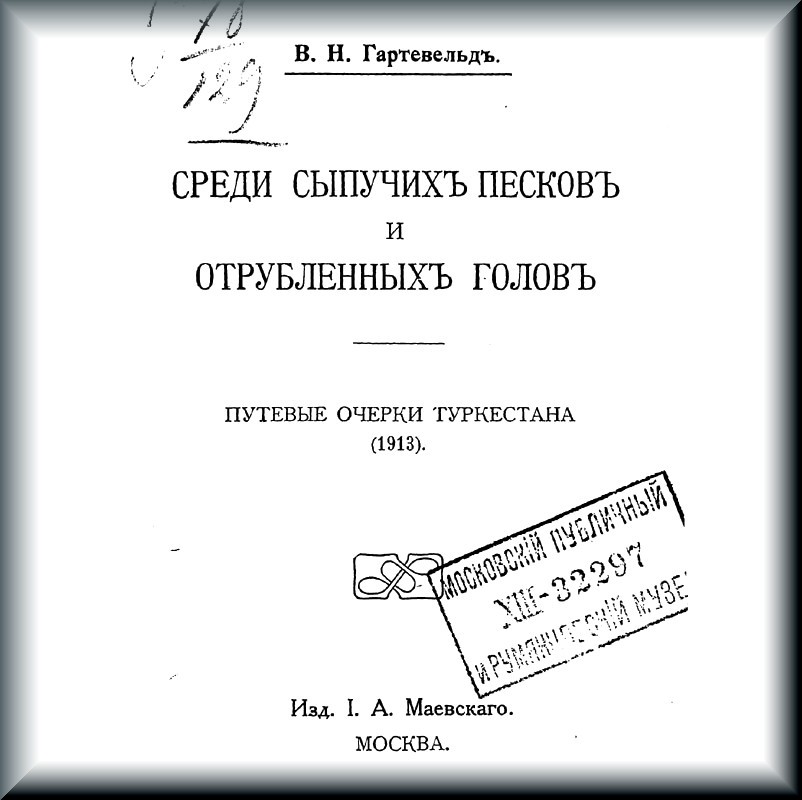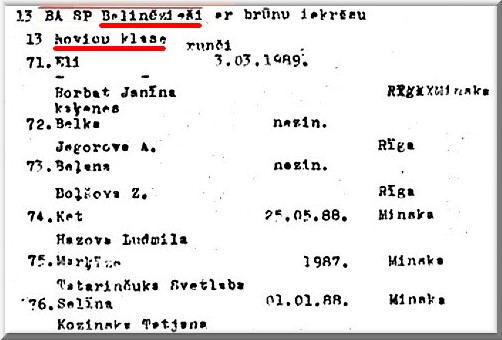The Siberian Cat : Part 2 |
||||
Siberian Cat : Without a MasqueradeSiberian Cat, from unknown unknown to known unknown | ||||
| Several years ago, I wrote a paper on the potential origins of the Siberian breed. That article has been considered as the first part of certain cycle of articles devoted to Siberian cats. Since then, however, almost five years passed, and neither I, nor anybody with longer experience in Siberians in Russia has managed to continue the cycle of papers available to foreign readers and devoted to this remarkable breed. It is not to blame Russian cat community that nothing has been done to familiarize the rest of the world with "what is going on" in SIBs, but, on the other hand, surprisingly little has been done except of important internal events such as seriously updating the "core original" Russian Siberian standard in 2005, and carrying out several workshops devoted to the future of Siberian breed. This is of course not to mention breeding itself in which some remarkable achievements have been made especially if comparing latest 4-5 years with mid-90s. | ||||
| Meanwhile, the breed has been spread around the world. Although there are SIB catteries now as far away from Russia as in Singapore, Australia, and South America, many people are still quite unaware of Siberians even in the good old Europe. Being at European shows, I most frequently hear a question from a casual spectator and even from a breeder with no relation to SLH breeds: "what is this cat?" Fortunately, modern felinology became so popular that most of the show visitors and attendees do understand that they neither see MCO, nor NFC, but something new and still uncommon. It is especially true if considering Siberians with rare colors almost never seen in other SLH breeds, such as e.g. golden. | ||||
| So, why the article sequels have been shelved for years? Mostly because the integrated picture of the present and future of SIBs lacked in the author’s mind. Although it is useful to appeal to the history, the most important is the future of the breed development, and this is not as evident and shining as it should be. And one should be very careful in making statements on the future of such a volatile idea as a cat breed development. Seeing thousands cats, collecting a lot of information, participating in numerous discussions, and in a workshop devoted to the amendment of the original Siberian breed standard, helped me a lot to form more or less consistent view on the current situation and on the future of Siberian breed. That was not possible five years ago, at the times when the consistency of Siberians has been seriously endangered, and any reliable genetic information on SIB breed was lacking. | ||||
Siberian standard and siberian archetype : seeing is believing ? | ||||
| The issues of the breed standard and the breed development were and will be the subject of quite heated debates. So, in this very part, I tried to present facts that can be verified by the members of SIB community with relative ease. Also, I hope that each reader will make his/her own conclusions, and, at the best, fortify them with other proven facts and observations. | ||||
| What are the most important topics in current development of SIB breed? First and foremost is the correct and consistent interpretation of the standard by all the breeders. As a young breed with old aboriginal roots, representing different lines in different locations both in Russia and abroad, Siberian cat needs clear identification of an archetype and building the archetype features into the standard. The standard itself and explanation of its peculiarities are highly important for such a native breed as Siberians. In view of this, I wrote a separate article devoted exclusively to that topic and based on the workshop held in 2005 and devoted almost exclusively to the SIB standard. This will be the part three and the final one to this moment of the SIB essay. As such, I will not consider the standard issues deeply in this part, however, some overlapping between the articles will be inevitable for the purpose of better understanding. The second topic logically ensuing from the breed youth is the problem of the breed consistency and the ways of the breed stabilization. And it is the issue currently severely hampering breed development both inside and outside Russia. Systematic breeding of Siberian cats started only 20 years ago, but it has already been experiencing significant problems. The following issues impeding certain aspects of SIB development, especially for foreign breeders are: 1st the "on default" consideration that 20 years ago, the SIB breed has been started not by amateur Argonauts rushed into a felinological fleece search, but by the felinology professionals, 2nd yet another belief that the cats from two Russia’s capitals indeed formed the Siberian breed, and 3rd the belief that cats imported decades ago from Russia can be used for development of modern SIBs as successfully as their remote descendants. With failure of such attempts, an opinion that SIBs lack any archetype has become widespread in certain breeder’s circles. | ||||
If not investing a lot of time in thorough research of pedigrees, one can express the common view that almost all the initial SIB genepool originates from St. Petersburg and from Moscow. This view is, however, not correct. If speaking about sheer numbers, yes, one can notice that more than 90% of the initial foundation population came from these two cities. (This is not taking into account cats that have been brought to Germany during last decade of USSR and later have been recognized as SIBs). But if speaking about the impact of certain lines on modern Siberians, it readily becomes evident that some foundation cats having greatest influence of further development of SIBs as the consistent breed, are in fact originating from outside Moscow and Saint Petersburg.
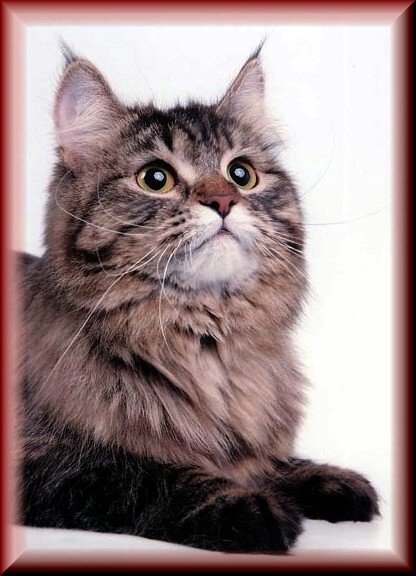
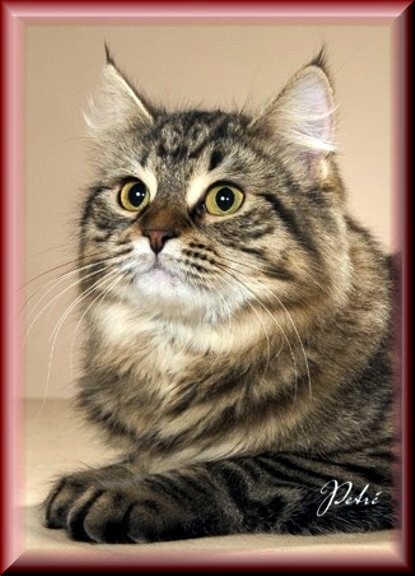 Famous Abakans (Amur, Aldan, and Argo), or to say more precisely, their immediate ancestry, came from Siberia and Far East. These males can be found in maybe half of pedigrees of Moscow’s SIBs, and they are of obvious Siberian and Far East origins. In general, a number of excellent and even outstanding SIBs have been born as the result of crossing Moscow lines and those from Siberia and Far East. Examples are not limited to the early Abakan line, but also represent Irdie (Treskuchii Sibirskii Moroz Mur), Busik, his offspring from Krasnoyarsk, and some other cats. This observation strongly suggests the existence of certain archetype in Siberians, that can be partly hidden in local populations, but is immediately revealed after quite a plethora of outcrosses between cats from different locations [Fig. 1 : please click on photo for a full sized view]. Famous Abakans (Amur, Aldan, and Argo), or to say more precisely, their immediate ancestry, came from Siberia and Far East. These males can be found in maybe half of pedigrees of Moscow’s SIBs, and they are of obvious Siberian and Far East origins. In general, a number of excellent and even outstanding SIBs have been born as the result of crossing Moscow lines and those from Siberia and Far East. Examples are not limited to the early Abakan line, but also represent Irdie (Treskuchii Sibirskii Moroz Mur), Busik, his offspring from Krasnoyarsk, and some other cats. This observation strongly suggests the existence of certain archetype in Siberians, that can be partly hidden in local populations, but is immediately revealed after quite a plethora of outcrosses between cats from different locations [Fig. 1 : please click on photo for a full sized view].
|
||||
| This observation is very important because it provides genetic proof of the concept by which the early description of the Siberian cat has been built. This other pair of photos depicts two females with distant relatives in the 8-9th knees of the pedigree. These females were born about five thousands kilometers apart, and none of their relatives ever met … except of the pre-Abakan cats originating from Siberia and Far East. This example is given only for the purpose of explaining why not numbers but gene combinations are important in claiming actual degree of participation in the breed foundation. In addition, this example outlines the Siberian cat archetype that could not been eradicated despite lack of systematic breeding in a number of catteries during early 90s. | ||||
Neva Cats : No Ace Ventura behind the Mask | ||||
| The third topic is the problem of Neva Masquerades and their relatedness to Siberians. This topic is actually a part of the previous one, and all the beliefs described above count for this very issue. Neva Masquerades have been accepted as a color variety of Siberian breed in a number of cat associations such as WCF, CFA, TICA etc. Main grounds of acceptance were arbitrarily described as "long persistence of said color variety among aboriginal semilonghair cats in Russia". No genetic analysis and analysis of actual origins of Neva cats was possible at the time of recognition. Participation of SLH colorpoint cats from the very beginning of SIB breed in Saint Petersburg (without careful analysis of their origins) has been considered as sufficient ground for the inclusion of Nevas into forming Siberians. Let us (with huge delay, but there is some excuse for that, as a reader can understand from this article) try to perform at least part of such analysis in order to better understand the roots of Neva Masquerades. | ||||
| Current Russian felinology is very competitive with a number of excellent cats and catteries of variety of breeds, known both nationally and internationally. Not only Siberians are recognized in all major cat associations in the world, but several other Russian native breeds have emerged, such as Don Sphinxes, Kurilean Bobtails, Peterbalds and few others, less known. One currently observing the state of art in Russian felinology, but lacking the longterm insight of experts as well as the insider’s knowledge of the situation 15-20 years ago, can infer that it was in the same state during those days, just like in their own (read Europe, US/Canada/Australia etc) country. Such a view will be a big mistake. I read at some websites of SIB catteries abroad that "in USSR cats were not allowed due to food shortage". This statement is funny, but not more than the assumption of an experienced and well-developed Russian felinology in existence 20 years ago. Luckily, acknowledgment of the SIB archetype was one the most important achievements of early breeders and cat judges. At that time, they did not compile comprehensive breed standard, and the SIB standard underwent a number of corrections during the past years. However, they captured the breed’s archetype features common both for big cities and for Siberian backwoods. | ||||
| Despite this success, the background at which SIBs and Nevas emerged was obviously formed by amateurs. Nowadays in Russian felinological media it is the "le ton mauvais" to remind about lack of systematic education of first Russian felinologists and to refer to actual origins of colorpoint "Siberians". It has become especially true since heated debates between anti-Neva and pro-Neva Big-endians and Little-endians taken place 3-4 years ago. I tend to express an irony here (courtesy to Jonathan Swift) because the arguments in those debates drawn by both sides were mostly senseless and ridiculous. For not to be unsubstantiated, I will just mention that the persons argued for making separate breed basing on Nevas have been accused in the attempts to "eliminate Nevas because they started to win over traditional Siberians at shows". It is interesting, however, why those pesky "Neva Terminators" or "Antinevists" haven’t been suspected in "elimination" of other competing SLH breeds such as MCOs, NFCs, TUAs etc etc. From the opposite camp, a quite ridiculous idea that all Nevas emerged as Persian outcrosses, has been launched. This was naturally rebutted by Pro-Nevists because indeed little or no Persians, especially no Himalayans were available in Russia during mid 80ies or earlier. On the serious and regrettable side, those debates have paved the broad way for hiding and perverting the facts about the origins of Nevas. A number of myths has been summoned to legitimatize Nevas as true and genuine Siberians. Although analysis of myths created 3-5 years ago it is not particularly interesting task (not as interesting as for the myths survived millennia of human history), it is what we need in order to understand the Neva origins, and trends of SIB breed development. | ||||
| The primary idea was that "colorpoint semilonghair cats have been present in Russia in numbers for centuries, together with other cats". As the "evidence", a case of so-called "Pallas cat" is frequently cited. Indeed, Pallas observed a colorpoint cat near Mokshan town (Volga river) in 1793 [Fig. 2 a] . On the basis of this observation, it has been "concluded" that colorpoint cats have been in Russia in abundance for centuries. However, close examination of this nice drawing obviously shows us a classic apple-headed shorthair Thai cat [Fig. 2 b, c], whose origin in South-East Asia is well-known and now is out of debates (see below). So, if trying to infer origins of Nevas from Pallas-like cats, Neva cat will not loose its origin as the outcross of Russia’s indigenous cat and a Thai cat. | ||||
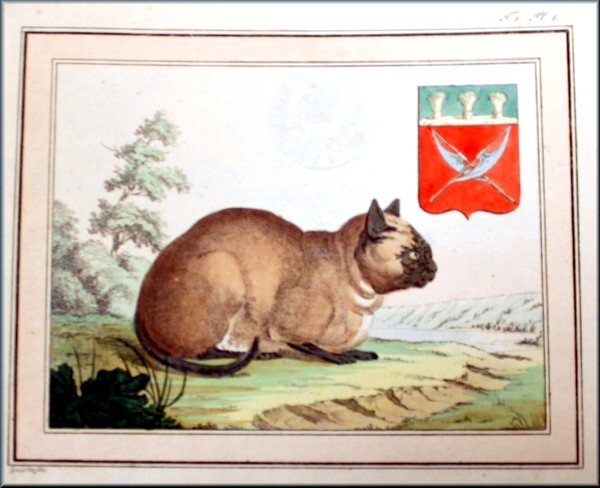
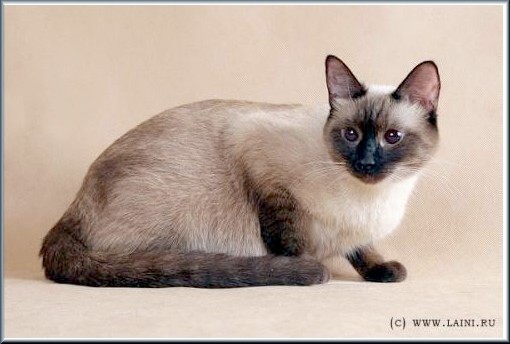
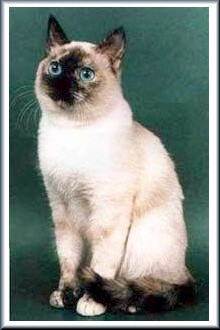 Fig. 2. a, b & c [please click on the photos for a bigger view] | ||||
| Let us refer to some sources of first-hand information by opening the book of Olga Mironova, "Aboriginal cats of Russia" issued in 2003, pages 29-31. This part of the book is devoted to Neva Masquerades. At the beginning of the chapter, Mironova absolutely openly admits that "It happened so that Siberian cats became a kin to proliferated offspring of Siamese (Thai – A. K.) cats imported to us from abroad by distinguished director of Puppet Theatre, Sergey Obraztsov" [1]. As we all understand, puppets and puppet theatres play significant role in the life of Russia and other countries as well, however, it cannot be considered as a reason to accept the outcrossed breed "Neva Masquerades" as Siberians. | ||||
| Was the Obraztsov’s case (Moscow) of importing colorpoint cats to Moscow a single one? Of course, it was not. Maybe even the import of parent(s) of "Pallas" (not to mix with true Pallas Cat, that is, Felis manul) cat by Volga’s basin merchants wasn’t the first one. Cats of unusual color did attract the attention of wealthy people at any times, so it is not surprising that some Thai cats could have been entering Russia centuries ago. However, this caused no reflection on Siberian kin at those times since even the sources describing notable (and quite expensive) Bukhara cats, close relatives of Siberians but imported from Central Asia by roughly the same Volga basin routes and thus had more chances to meet Thai cats than any other Russian cats of that era, speak about brown tabbies and keep absolute silence about Bukhara (or Zeravshan, that is a nearby river –A. K.) Masquerades [3. Garteveld V. I. Amidst loose sands and cut throats. Moscow, 1913]. | ||||
| Thai cats were popular in Soviet Union, especially after establishing of closer relations with Indochina’s countries at late 60s. My uncle, who lived in Caucasus was the proud owner of a Thai cat since 1972. That was a typical colorpoint apple-headed shorthair cat with kinked tail brought from Vietnam by oil geologists. Of course, main ports such as St. Petersburg and Vladivostok were primary gates of entering Thai cats to Russia during those times. That is the most natural explanation on why the cp gene is abundant in these cities, especially in St. Petersburg, but is rare or absent in the rest of Russia (except of Moscow that is and was the center of everything). | ||||
| Description of Neva Masquerades as the outcross between Thais and Siberians was given by several authors in a felinological media of Russia and former Soviet Union. Only after the fire of the "Endians’ " wars went down in ca 2004, it has become politically incorrect to mention the origins of Nevas, and since then Mironova’s book has been cited only partially, e.g. "true Siamese, Balinese, and Himalayan cats entered Russia long after recognition of Nevas, and have never been used in development of Neva Masquerades" (ibid, p.30). Also, some citations of well-known Siberian breeders have been rapidly forgotten. T. E. Pavlova wrote in 2002 in the Ukrainian "Tvoya Koshka" (Your Cat) magazine: "First emerging in St. Petersburg, Neva Masquerades immediately attracted public attention. Characteristic features taken from Thai (old-type Siamese) did not impair the type of Siberians, but rather introduced refined charm and exotic into the breed". | ||||
Following Mironova’s text, I mentioned Balinese cats. Here we are approaching one of the culprits of this story, i.e. how and why quite a number of colorpoint cats have become Neva Masquerades in a short period of time. I am watching a videotape record from a cat show of now dissolved cat club "Soyuz" taken place in ca 1994. I see many famous SIBs there, Svetik, Bukashka, Knyaz Vasiliy, and some others. At the same time, I see proud couple holding huge and muscular colorpoint SLH cat saying "And it is our Balinese". Nowadays this big cat could have been referred to as Neva Masquerade with almost 100% confidence. Let us return to the "Aboriginal cats of Russia". "During first cat shows, SLH cats of Siamese color have been inscribed for breed recognition. They (as a rule – A. K.) have been immediately ascribed to Neva Masquerades. Sometimes owners of such cats described them as Balinese by themselves… I have been forced to make a description of these cats as domestic ones, or as Neva Masquerades if they deserved that". However, first shows have been held at the late 80s, and the show we are discussing here has been held not earlier than at the end of 1993 according to participating Siberian cats whose registration dates are known. Therefore, times when owners could "describe the cat by themselves" have already been well in the past. And of course these "Balineses" of 90s mostly occurred due to the acceptance of inexperienced "judges". Actually there is nothing unusual in the mentioned "Balinese" case. "Transferring" of "Balineses" to Nevas at the end of 80s is described in colours in the online article of WCF Judge Irina Sadovnikova and is supported by citing appropriate pages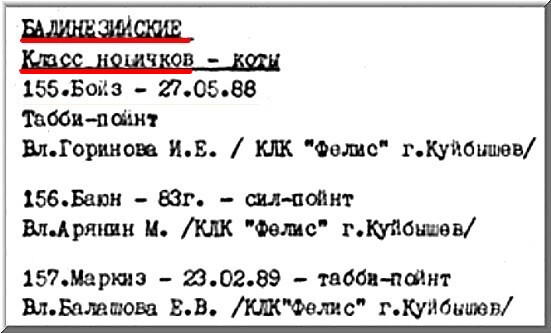 from the catalogues of cat shows from the time. Russian felinology matured only relatively recently, and at the beginning there was common trend to create own "replicas" of well-known foreign breeds because Western prototypes were out of reach for Soviet and then Russian cat fancy due to financial, communication, and other reasons. At the beginning, "homemade" Norwegian forest, Siamese, Balinese, European Shorthair (the latter with more rights to exist in Russia) occupied significant part of cat shows.[click on photo for more] from the catalogues of cat shows from the time. Russian felinology matured only relatively recently, and at the beginning there was common trend to create own "replicas" of well-known foreign breeds because Western prototypes were out of reach for Soviet and then Russian cat fancy due to financial, communication, and other reasons. At the beginning, "homemade" Norwegian forest, Siamese, Balinese, European Shorthair (the latter with more rights to exist in Russia) occupied significant part of cat shows.[click on photo for more]
| ||||
| What was the reason to this? Obviously, the reason was mostly financial because kittens of the "rare breed" could have been sold with much more success than e.g. brown tabby SLH "alley" cats. Also, there was great desire of significant part of young cat fancy to see their household pets as "pedigreed" cats. To the current situation, occurrence of these "Balinese" cases just mean that quite a number of colorpoint SLH cats later became Neva Masquerades have the origins other than occasional outcrosses of Thai cats with Russia’s alley cats in 60s-80s. | ||||
Spread of colourpoint mutation : Growing a needle in the haystack | ||||
| In the above-mentioned book, Mironova says about "recent explosion" in numbers of cp "SIBs". Let us analyze, can this explosion occur easily due to natural reasons such as plain increase in the number of catteries, increase in guided breeding events etc. That the colorpoint mutation is present in all mammals is a Punchinello's Secret. However, in most of the populations this mutation is extremely rare. Despite all the power of modern molecular biology, it is still only one case of unequivocal detection of "Siamese" mutation in humans [2]. Cats from Southeast Asia represent unique mammalian pool in which this mutation is abundant. In other cats is as rare as in the rest of the mammals. | ||||
It is known that colorpoint mutation is present in the well-known Abakan line whose ancestors are cats from the Abakan cattery, Amur, Aldan, and Argo Abakans and some relatives of their parents. The known carrier of this mutation was Mura, the foundation cat of the De Glemur cattery. Mura, born in the mid 80s, herself has no relevance to Abakans, it is Moscow-originated cat that could acquire cs gene from e.g. Thai cats or their descendants. Despite abundant presence of Mura in pedigrees of Moscow-bred cats, only a handful of colorpoint cats were born within these lines, some in Moscow, some in Finland, some in US and some in Poland. To the best of my knowledge, during ca 15 years of breeding within these lines, less than ten litters containing colorpoint kittens was born. Of course, when these colorpoint kittens were used with other colorpoints in purposeful breeding, the numbers increased. But if speaking about spontaneous emergence of colorpoints (and breeding of Mura’s offspring for many years represents unique experiment because that breeding had no purpose to select colorpoint cats among other colours), the percentage appears to be very low. Thus, the reasons for "explosion" in the numbers of colorpoint cats during early 90s is anything else but plain "out of the blue" increase of numbers of cp kittens among already existing Siberian lines during breeding. One of the reasons for this increase was the selection for "Balinese" cats and further re-determination of many of them as Neva Masquerades. It is now not known which XLH cats were used to generate "Balineses", but it is quite obvious that many of them had little relevance to Siberians simply because "Balinese" catteries did not care about that. Another source was of course outcrosses, 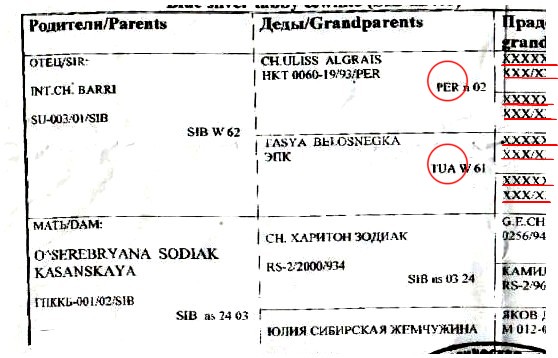 purposeful or occasional. There is some evidence of crossing Siberians with Persians in "experimental" pedigrees of some Russian clubs, but unequivocal evidence is lacking if those crosses yielded any colorpoint cats further used in breeding. Although there is a lot of rumors regarding deliberate use of Persians and Thai cats during early to mid 90s to "create" new lines of Nevas, direct evidence of such actions is currently lacking. Either pedigrees reflecting these events have been later "cleansed" or the trend was not mass, especially taking into account already maturing felinological community.[a click on the image will open a bigger sized photo] purposeful or occasional. There is some evidence of crossing Siberians with Persians in "experimental" pedigrees of some Russian clubs, but unequivocal evidence is lacking if those crosses yielded any colorpoint cats further used in breeding. Although there is a lot of rumors regarding deliberate use of Persians and Thai cats during early to mid 90s to "create" new lines of Nevas, direct evidence of such actions is currently lacking. Either pedigrees reflecting these events have been later "cleansed" or the trend was not mass, especially taking into account already maturing felinological community.[a click on the image will open a bigger sized photo]
| ||||
Concluding remarks | ||||
| Basing on the above material, the following conclusions can be made regarding origins and spread of Neva Masquerades: | ||||
| There were several waves of Nevas entering the Siberian breeding pool, each originating under certain unique circumstances, and thus having unique genetic background. First wave emerged at the end of 80s when a number of fancy colored cats of Moscow and St. Petersburg have been recognized as Siberians because they "were the product of Mother Nature breeding between Russian aboriginal and Thai cats". Only recent genetic analysis has shed some light on the difference between "Mother’s Nature" genetic background and the resulting mixed genotype. Second wave came with rise and fall of Balinese cats of Russian vintage when the Russian felinological community grew out of its infancy and realized that their Balinezski, Norwezhski, and Siamski will never be accepted by the rest of the world. The third wave was rather a ripples caused by occasional attempts to "increase the numbers" and "broaden the genepool" of Siberians by outcrossing them with Persians. Speaking strictly, the impact of the last wave of cp mutation is likely to be minor, and more harmful was the spread of fluffy PER-SIB hybrids that have been considered by certain people as more "Siberian" than true breed representatives. | ||||
| During almost all the time except of very recent years, there was open acceptance of the fact published in books as well as in periodical media that Neva Masquerades emerged in big cities as the outcross of Thai and Russia’s native SLH cats mostly during the second half of XX century. Such open acceptance, however, rapidly faded when certain part of the developing Russian felinological community tried to impeach the idea of identity between Nevas and traditional Siberians. | ||||
| The argumentation on the long-term existence of colorpoint cats in Russia in any significant numbers cannot be accepted because these cats did not leave any detectable traces in history and folklore except of Pallas’ drawing of one Thai-looking cat. On the contrary, Bukhara cats who are close relatives (or maybe even ancestors) of modern Siberians have always been described as cats of wild-type coloration. Till now big, "fluffy" and "grey-striped" cats in the regions of southern Ural, Moslem autonomous republics of Russia, and Central Asian countries are called "Bukhara", and not "Siberian" cats. This is important because the population of Bukhara cats had much more chances to encounter cats from South-East Asia brought there via prolific merchants’ routes, than any of the cats living on Russia’s territory. Garteveld indicates that the price of a pair of Bukhara cats is "75-100 rubles, and here (in Asia – A. K.) they are not significantly cheaper than in Moscow". The sum of 100 rubles at the beginning of XX century in Russia was approximately one-half to one-third of the annual salary of a worker or a clerk. It is unlikely that the presence of other remarkable cats such as colorpoints at Russian or neighbouring markets would have been passed without a trace. | ||||
| As cited above, the main basis for "legitimizing" Neva Masquerades as part of Siberians is as follows: 1. outcrosses of Russian SLH cats with Thai cats occurred before breed recognition, and 2. Thai cats already represent the pool of Russia’s indigenous cats. Both statements are, however, proved wrong. Quite a number of outcrosses of colorpoint cats with those genetically and phenotypically irrelevant to Siberians occurred years after SIB and Neva recognition, and initially had no purpose to generate Neva Masquerades, but rather to breed "Balineses". Only with a growing understanding of this way of breeding as being the wrong one, a significant part of these cats was "transferred" to Neva Masquerades in ca 1992-1995. Of course, and according to O. Mironova´s statements, this "transfer" took place during the 80s as well. | ||||
| The most important is that recent molecular genetic analysis unequivocally demonstrated that Siamese clade of cats (in which Thai cats represent one of the archetypes) is genetically most distant from the rest of the cat breeds as well as from European and Mediterranean alley cats [4]. Siberian cats included in that study represent no exception and are located at the opposite branch of this genetic tree. Importantly, this analysis was done not by comparing colorpoint against non-colorpoint cats, but rather cats of SEA and the other regions with no regard to coloration. For example, Korats included in that analysis have been shown to genetically belong to the SEA clade and appeared as distant from other cats as their colorpoint cousins [5]. | ||||
| These data indicate that cats of SEA region have been geographically separated from the rest of the domestic cat population for quite a while, and acquired unique structure of the genome. Within the native (Siberian) breed concept, it is therefore very little sense in crossing the animals (Thais and Russian SLH cats) that are as genetically distant as it is possible within the evolutionary tree of domestic cats, and in declaring such an outcross to be "natural" and "useful". In fact, massive outcrossing of genetically distant cat populations inevitably results in loss of the unique traits of both clades. Instructively, it is what occurred with Persians, probably the most advanced breed, if speaking about extremalization and development of artificial traits in pedigreed cats. Although there are little doubts in the historical origins of Persians from Iran and Middle Asia, and close relatives of these cats, Angoras and Vans indeed possess region-specific features in DNA, whereas Persians lost them completely. Persians are thus representing a stark example of what happens with the genetic background of a breed if breeding proceeds only towards the desired artificial-looking extreme type paying no attention to how this type has been achieved. What is fully permissible in the case of an artificial breed is totally unacceptable, if speaking about preservation of genetic uniqueness of a native breed such as Siberians. | ||||
| Why rapid loss of unique genetic background is inevitable in Siberian-Thai pointed outcrosses aimed at propagation of colorpoints? It is because the colorpoint gene is recessive. It is relatively easy to introduce a dominant trait (e.g. silver color) into a cat population while largely preserving the genotype of this population. Since dominant trait is always "visible", it can be bred into a cat population by using single ancestor and by monitoring the trait by eye. During several generations of breeding, each time with the cat that represents new member of the said population, the traits "imported" with the desired dominant one are gradually "washed out" of the population. The only thing needed to make such a genetic "laundering" highly efficient is to remove all the "intermediate" cats from breeding. | ||||
| On the contrary, in order to perform "clean" breeding-in a recessive colorpoint gene into a cat population, one should have understanding of molecular genetics, and be ready to invest considerable time and funds into performing at least several tens (better hundreds) DNA tests. One can afford seamless introduction of recessive gene into new background, according to the above scheme, only using strict control of heterozygotes at each breeding step. These heterozygous cats containing normal and colorpoint alleles will lack colorpoint phenotype, and their genotype must be revealed by DNA test (polymerase chain reaction, PCR). | ||||
| There are some unpublished indications that the genome of Siberian cats contains DNA sequences uncommon in other breeds. For example, Siberians are thought to cause less allergic reactions comparing to any other cat breed. Whether it is indeed the case, remains to be investigated, but spread of foreign genes from Thai and other colorpoint-carrying cats in Siberian population can rapidly eliminate the opportunity to know if there was a real molecular mechanism behind this. | ||||
| Additional study is needed to confirm these initial findings, but if consider unrestricted breeding of Siberian cats with Neva Masquerades already containing significant proportion of non-native genetic material, the uniqueness of Siberian genome is at risk to never been described. | ||||
| In my opinion, consequences of introduction of Neva Masquerades in Siberians are quite obvious. In Russia, despite all debates the trend to breed Nevas and Siberians separately has never changed and only a small fraction of catteries practices the opposite. Hope that the information presented in this paper will be useful for current and future Siberian breeders worldwide. | ||||
© A. V. Kolesnikov, PhD, Senior Scientist, Shemyakin & Ovchinnikov Institute of Bioorganic Chemistry, Russian Academy of Sciences. Moscow, Russia, January 2004-May 2008 | ||||
